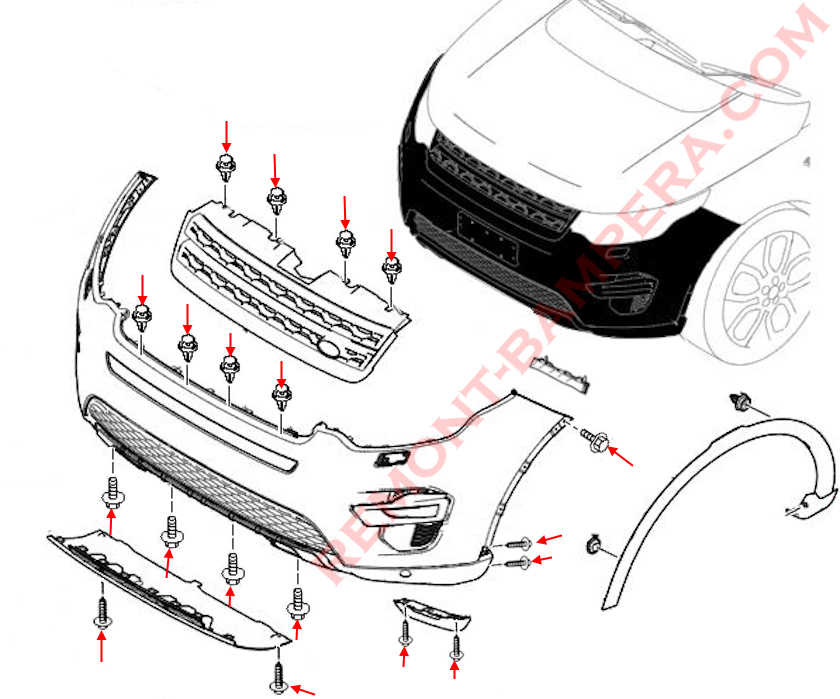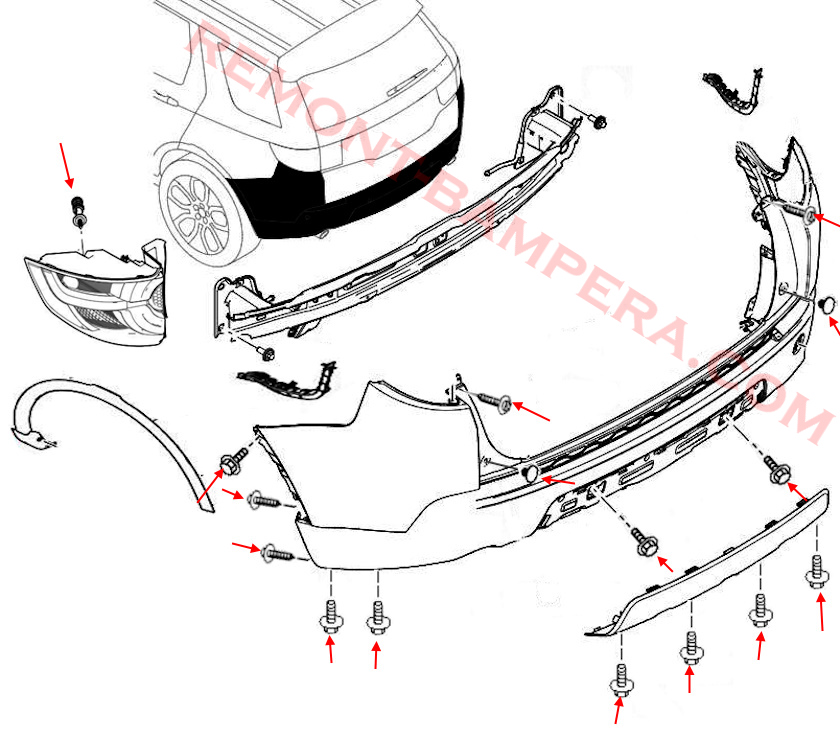The Land Rover Discovery Sport I is the first generation of the popular compact SUV, launched in 2014 as a replacement for the Freelander 2. Coded L550, this model quickly won over brand fans with its combination of practicality, modern design and genuine off-road capability.
Model Updates and Evolution
Initially produced from 2014 to 2019, the Discovery Sport I underwent a major facelift. The updated version (2019-2024) received a redesigned front end: new LED headlights, a Range Rover-style grille, and a revised bumper. The interior gained a digital instrument cluster, upgraded materials, and the Touch Pro infotainment system with a large touchscreen.
Technical changes affected the powertrains - older petrol and diesel engines were gradually replaced with new units, including hybrid versions. In 2022, the model received minor updates with new features and improved driver assistance systems.
Bumper Materials (may vary):
- Polypropylene/ethylene-propylene blend, 15% filler. Marking >PP+E/P+TD15<
- Polypropylene with 12% filler. Marking >PP-12%TF<
Front Bumper Removal
- Open the hood
- Under the hood, remove 4 clips (inserted top to bottom), release the latches (pull toward you) and remove the grille
- Under the grille, remove 4 clips (inserted top to bottom)
- Turn the wheels inward
- Release the front part of the fender liners (held by clips, pull toward you starting from bottom)
- Under the liners, remove one bolt per side securing the corners to the fenders
- Remove four bolts per side securing the wheel liners and deflectors (from 2019, remove two additional clips), release the liners
- Under the vehicle, remove two bolts (six bolts and two clips from 2019) and remove the lower cover
- Under the cover, remove four bolts (10mm, screwed bottom to top) securing the lower part of the front bumper
- Release the clips in the fenders (pull toward you)
- With an assistant, remove the bumper by pulling forward (be careful not to damage wires and hoses)
- Disconnect the main electrical connector and hoses



Rear Bumper Removal
- Open the tailgate
- In the trunk opening, remove two plastic plugs
- Open the covers in the side trunk trim
- Under the covers, remove two plastic screws and remove the taillights
- Under the lights, remove one screw per side securing the top of the rear bumper
- Under the vehicle, remove four bolts and remove the cover (held by clips)
- Under the cover, remove two bolts
- Remove two bolts per side (screwed bottom to top) near the wheel arches
- Release the fender extensions (rear part, pull toward you)
- In the wheel wells, remove two screws per side and release the rear part of the liners
- Under the extensions, remove one bolt per side securing the corners to the fenders
- Release the clips in the fenders (pull the corners toward you)
- Release the clips in the tailgate opening (press with flat screwdriver and pull)
- With an assistant, remove the bumper by pulling backward (watch for wires)
- On the right side, disconnect the main electrical connector


Design and Features
The Discovery Sport I inherited Discovery's signature traits: stepped roof, pronounced wheel arches and distinctive grille. More streamlined and modern than the angular Freelander, it offers up to 5+2 seating (optional third row), making it one of few compact SUVs with 7 seats.
The cabin reflects British minimalism: quality leather, aluminum trim and well-placed controls. Base models had an 8-inch screen, while top trims added a panoramic roof, heated seats and premium Meridian audio.
Technology and Off-Road Capabilities
Available with front-wheel or all-wheel drive (Terrain Response system) and multiple engines:
- Petrol: 2.0L Ingenium (240-300 hp)
- Diesel: 2.0L TD4 (150-240 hp)
- Hybrid: PHEV version (309 hp, up to 55 km electric range)
6 or 9-speed automatic transmission. Despite its urban looks, it retains Land Rover DNA: 212 mm ground clearance, traction control, electronic differential lock and 60 cm wading depth.
Interesting Facts
- Freelander successor positioned higher in Discovery lineup
- Produced in UK, China, Brazil and India
- Rally-inspired Discovery Sport SVX concept shown in 2015 (never produced)
- Used by emergency services for its capabilities
- PHEV was among brand's first hybrids
Conclusion
The Discovery Sport I successfully blends urban SUV and true off-roader. Maintaining Land Rover DNA while gaining modernity, its updates extended its success. Even after being replaced in 2024, it remains desirable on the used market, especially in premium AWD versions. An ideal choice for those who appreciate British style, versatility and a mix of status and performance.

 English
English  Italiano
Italiano  Français
Français  русский
русский  Deutsch
Deutsch  Español
Español